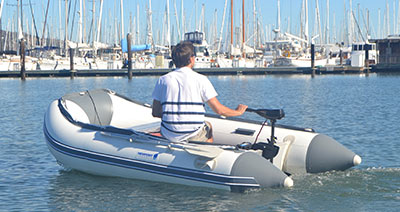Electric Trolling Motors
By Chuck Brod
An electric trolling motor is one of the most useful pieces of equipment you can install on your fishing boat.
They can be used as:
1. The primary motor in moving your boat
2. A backup motor in case of a failure of your gas motor
3. Used for trolling where legal
4. Moving your boat a short distance to fish a new spot
5. Moving slowly along a piece of fishing structure while you fish or
6. Holding your boat’s position on top of a piece of structure.
These and many other uses make the electric trolling motor a valuable tool for fishing.
The four main areas that need to be considered when purchasing an electric trolling motor are:
1. Shaft/Tube Length. The tube of the motor must be long enough to totally submerge the prop approximately one foot into the water. You need to consider that if the motor is on the bow of the boat and you are in waves the prop still needs to remain submerged to retain control of the boat.
If you get too long of a shaft, when you stow the motor into the boat it may interfere with the front seat, rod holders, electronics or stick out past the side of the boat. You can refer to the shaft length guide in the manufacturer’s sales catalogue or, if possible, measure a similar boat to yours that has a motor installed to get a good idea what length you should have.
2. Voltage. Most electric motors for fishing come in 12 and 24 volts. This simply is how many 12 volt batteries you wire in series to develop the voltage you need for the size motor you have.
One-12V battery = 12 volts.
Two-12V batteries = 24 volts.
The higher the voltage the more powerful the motor you can use. Another advantage of higher voltage is increased running time between battery charges.
To wire a 12 volt system, attach the positive (+) red wire from your motor to the positive (+) post of the battery. Attach the negative (-) black wire from your motor to the negative (-) post of the battery.

To wire a 24 volt system, attach the positive (+) red wire from your motor to the positive (+) post of battery #1. Attach the negative (-) black wire from your motor to the negative (-) post of battery #2. Now you have to attach a short jumper wire between the negative (-) post of battery #1 to the positive (+) post of battery #2.
3. Pounds of Thrust. Pounds of thrust relate to the amount of power you are going to get out of your electric motor to either push or pull your boat through the water. The weight of the boat, wind, and current all need to be considered when choosing how many pounds of thrust you will need for your fishing situation.
Pounds of thrust are directly related to the amount of voltage you have available. 12V systems will develop up to approx. 55 lb of thrust. 24V systems will develop up to approx. 80 lb. of thrust. 36V systems will develop up to approx. 105 lb. of thrust. If you have a 14′-16′ lighter fishing boat the 40-55# thrust will work well. If you have a 16′-18′ heavier fishing boat the 70-80# thrust will work well. The heavy boats over 18′ may require up to 105# pounds of thrust.
You need to consider the amount of space you have in your boat to store your batteries. Some of the largest fishing boats may use up to five 12V batteries for the electric motors, starting motor and all the other electronics.
4.Where You Mount The Motor.
Stern Mount.
When using an electric trolling motor as your primary motor, or are using it mostly for trolling or moving very short distances, it should be mounted on the transom (back) of the boat as you will be in the back of the boat to control the motor by hand. The transom model motors are simpler to run as they are controlled just like an outboard motor.
Bow Mount.
In most applications of fishing it is better to mount the motor to the bow as it is more efficient to pull the boat through the water than to push it. You will get maximum boat control, minimize over steering, and when fishing from the front of the boat you may be able to see underwater obstacles such as rocks and stumps. Boat control is a lot easier when pulling the boat versus pushing it. The three methods of controlling the motor from the bow are: 1) hand control; 2) cable steering or 3) power drive.
Hand Control.
Advantages: Simple to steer and change speed. Can quickly respond to objects in the water.
Disadvantages: Only can run motor from the very bow of the boat. Length of the shaft needs to be longer so you can reach the handle control without bending over.
Cable Control.
Advantages: Faster steering. The mounting bracket built to withstand hitting underwater objects. Less service issues as motor relies on mechanical versus electrical steering. Best suited in fishing situations where you can fish and catch fish from the front of the boat.
Disadvantages: You’re limited to controlling the motor only where the foot pedal is mounted.
Power Drives.
Models that are controlled by a foot pedal that is connected to the motor by a flexible cord. The cord is long enough to reach most places in your boat so you can control all the functions of your motor in the boat. The power drives are very popular in fishing situations where you need to control the boat from anywhere in the boat while fighting larger fish.
Chuck Brod owns and operates Sportsmans Repair Shop located in Mosinee, Wisconsin“Specialists in the Repair of Fishing Tackle and Electric Trolling Motors” For more information please visit SportsmanRepair.Com